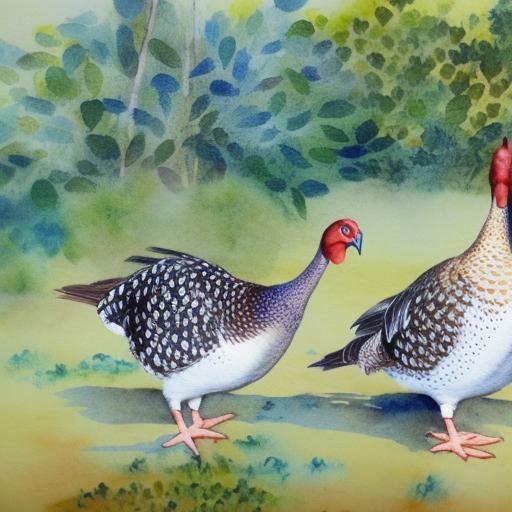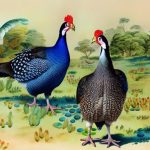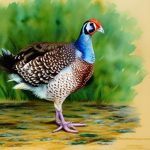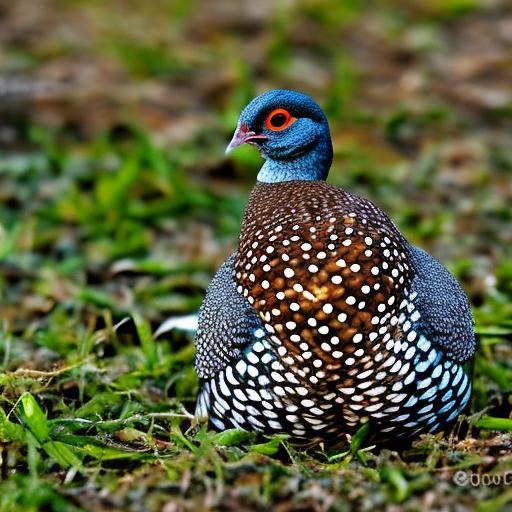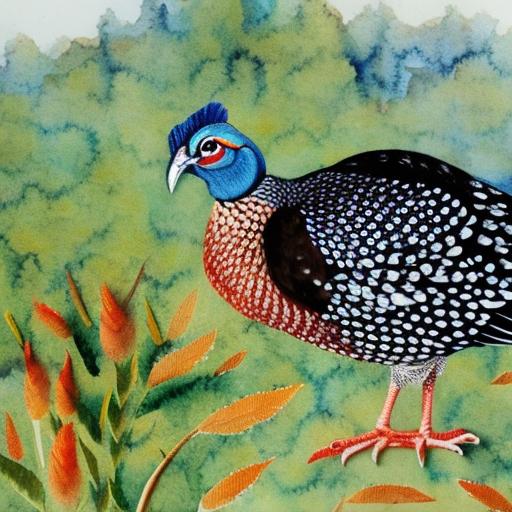Guinea fowl, also known as pintades, are native to the African continent and are known for their unique breeding behavior. They are monogamous birds, meaning they form long-term pair bonds with a single mate. These birds are highly social and prefer to live in flocks, which is reflected in their breeding behavior. Guinea fowl are also known for their loud calls and distinctive plumage, making them a popular choice for backyard poultry enthusiasts.
When it comes to breeding, guinea fowl exhibit fascinating behaviors that are worth exploring. From courtship and mating rituals to nesting and egg laying, these birds have a complex and intriguing breeding process. Understanding their behavior is essential for successful breeding and raising of guinea fowl.
Key Takeaways
- Guinea fowl are known for their unique breeding behavior, which includes complex courtship and mating rituals.
- Nesting and egg laying in guinea fowl are typically done in secluded areas, and the females are known to be very secretive about their nesting sites.
- The incubation and hatching process for guinea fowl eggs usually takes around 26-28 days, and the chicks are precocial, meaning they are able to feed themselves shortly after hatching.
- Guinea fowl exhibit strong parental care and are known to be protective of their chicks, teaching them how to forage and avoid predators.
- Social dynamics within breeding flocks of guinea fowl are complex, with dominant males and females often leading the group and establishing hierarchies.
- When breeding guinea fowl, it’s important to consider challenges such as predation, disease, and proper housing and nutrition for the birds.
Courtship and Mating Rituals
Guinea fowl have elaborate courtship and mating rituals that are essential for pair bonding and successful reproduction. During the courtship phase, the male guinea fowl will display his plumage and perform a variety of vocalizations and displays to attract a mate. These displays can include strutting, puffing up their feathers, and making loud calls to impress the female. The female will then assess the male’s displays and choose a mate based on his performance.
Once a pair bond is formed, the male and female guinea fowl will engage in preening each other’s feathers and engaging in mutual grooming behaviors. This bonding process is crucial for the success of their breeding efforts. Once the pair has bonded, they will engage in mating rituals, which involve the male mounting the female and copulating. This process ensures fertilization of the eggs and sets the stage for the next phase of the breeding process.
Nesting and Egg Laying
After mating, the female guinea fowl will begin to search for a suitable nesting site to lay her eggs. Guinea fowl are ground nesters, meaning they prefer to lay their eggs in hidden locations on the ground. The female will often choose a secluded spot with dense vegetation to build her nest and lay her eggs. She will use twigs, leaves, and grass to construct a shallow depression in the ground where she will lay her eggs.
Guinea fowl are prolific layers, with females laying an average of 25-30 eggs per breeding season. The eggs are small and speckled, with a hard shell that helps protect them from predators. The female will lay one egg per day until she has completed her clutch, which can range from 8-15 eggs. Once the clutch is complete, the female will begin the incubation process to hatch her eggs.
Incubation and Hatching Process
After the female guinea fowl has completed laying her clutch of eggs, she will begin the incubation process. Guinea fowl are known for their strong maternal instincts, and the female will diligently incubate her eggs for approximately 26-28 days. During this time, she will rarely leave the nest, only taking short breaks to feed and drink.
The incubation period is a critical time for the eggs, as they require consistent warmth and humidity to develop properly. The female will carefully turn and rotate the eggs to ensure even heat distribution and proper development. As the hatch date approaches, the female will become more vocal and attentive to her eggs, often emitting soft clucking sounds to communicate with her unhatched chicks.
Once the eggs begin to hatch, the female will assist her chicks by gently pecking at the eggshells to help them break free. The hatching process can take several hours, and the female will continue to care for her chicks once they have emerged from their shells.
Parental Care and Chick Rearing
After hatching, the female guinea fowl will provide attentive parental care to her chicks. She will lead them away from the nest site in search of food and water, teaching them essential survival skills. The chicks are precocial, meaning they are born with their eyes open and are able to walk and feed themselves shortly after hatching.
The female will protect her chicks from predators and teach them how to forage for insects, seeds, and other food sources. She will also provide warmth and shelter for her chicks, often gathering them under her wings at night or during inclement weather. The male may also play a role in chick rearing, providing protection and guidance as the chicks grow and develop.
As the chicks mature, they will gradually become more independent, but the parental care provided by the adult guinea fowl is essential for their survival during the early stages of life.
Social Dynamics within Breeding Flocks
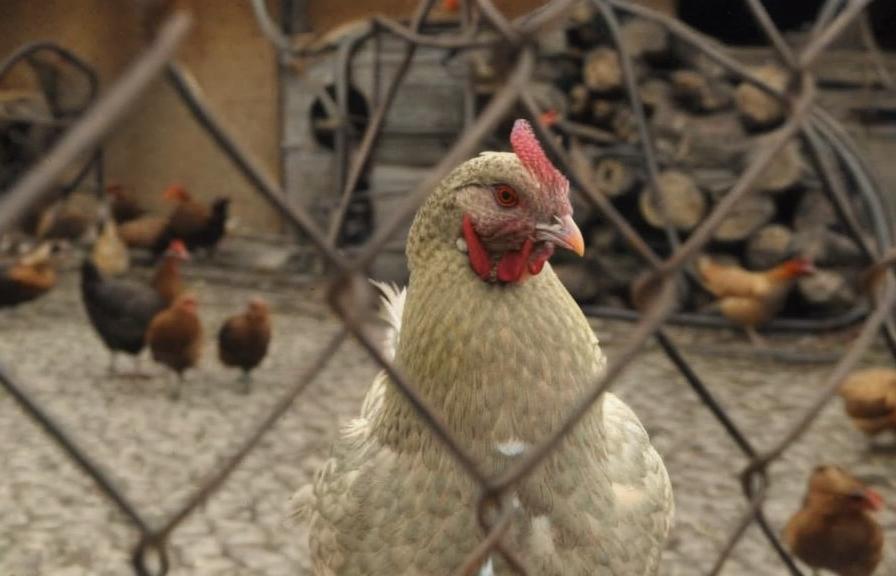
Guinea fowl are highly social birds that prefer to live in flocks, and this social dynamic extends to their breeding behavior as well. Within a breeding flock, there is often a dominant male who will mate with multiple females. The dominant male will engage in courtship displays and rituals with each female in his harem, ensuring successful reproduction within the flock.
The females within the flock will form close bonds with each other, often sharing nesting sites and engaging in cooperative behaviors such as mutual grooming and chick rearing. This social structure helps to ensure the safety and well-being of the entire flock, as individuals work together to protect each other from predators and provide support during the breeding process.
The social dynamics within a breeding flock also play a role in communication and coordination during courtship, mating, nesting, and chick rearing. Guinea fowl use a variety of vocalizations and body language to communicate with each other, signaling their intentions and coordinating their behaviors within the flock.
Challenges and Considerations for Breeding Guinea Fowl
While breeding guinea fowl can be a rewarding experience, there are several challenges and considerations to keep in mind. One of the primary challenges is predation, as guinea fowl are vulnerable to a variety of predators including foxes, raccoons, hawks, and snakes. Providing secure housing and predator-proof enclosures is essential for protecting breeding pairs and their offspring.
Another consideration is the need for adequate space and foraging opportunities for breeding flocks. Guinea fowl are active foragers that require access to a diverse range of insects, seeds, and vegetation to meet their nutritional needs. Providing a spacious outdoor environment with access to natural foraging opportunities is important for maintaining healthy breeding pairs.
Additionally, it’s important to consider the potential for aggression within breeding flocks, particularly during courtship and mating rituals. Dominant males may exhibit aggressive behaviors towards rival males or females within the flock, which can lead to injuries or stress. Providing ample space and opportunities for individuals to establish their territories can help mitigate aggression within breeding flocks.
In conclusion, guinea fowl breeding behavior is complex and fascinating, encompassing courtship rituals, nesting and egg laying, incubation and hatching processes, parental care and chick rearing, social dynamics within breeding flocks, as well as challenges and considerations for successful breeding. Understanding these behaviors is essential for anyone interested in breeding guinea fowl, whether for agricultural purposes or as backyard poultry. By gaining insight into their natural behaviors and needs, breeders can create optimal conditions for successful reproduction and healthy offspring within guinea fowl breeding flocks.
If you’re interested in learning more about guinea fowl breeding behavior, you may also want to explore an article on the importance of providing a suitable coop for chickens. Understanding the specific needs and behaviors of poultry, whether it’s guinea fowl or chickens, is crucial for successful breeding and overall well-being. Check out this informative article on what kind of coop is best for chickens to ensure you’re creating the ideal environment for your feathered friends.
FAQs
What is guinea fowl breeding behavior?
Guinea fowl breeding behavior refers to the mating, nesting, and rearing of young by guinea fowl birds. This includes courtship displays, selection of mates, and the care of eggs and chicks.
When do guinea fowl breed?
Guinea fowl typically breed during the spring and summer months, with the exact timing varying depending on the species and local climate. They are seasonal breeders and will often lay eggs in the warmer months.
How do guinea fowl choose a mate?
Guinea fowl choose their mates through courtship displays, which can include vocalizations, strutting, and wing displays. Males will often compete for the attention of females, and the females will select a mate based on these displays.
Where do guinea fowl build their nests?
Guinea fowl will often build their nests on the ground, typically in hidden or sheltered locations such as under bushes or in tall grass. They will use materials such as leaves, grass, and feathers to construct their nests.
How many eggs do guinea fowl lay?
Guinea fowl hens can lay anywhere from 30 to 60 eggs per year, depending on the species and individual bird. They will typically lay their eggs in a single clutch, with each egg being laid a day or two apart.
How do guinea fowl care for their eggs and chicks?
Guinea fowl hens will incubate their eggs for about 26-28 days, and both the male and female may take turns sitting on the eggs. Once the chicks hatch, the parents will lead them to food and protect them from predators.
Meet Walter, the feathered-friend fanatic of Florida! Nestled in the sunshine state, Walter struts through life with his feathered companions, clucking his way to happiness. With a coop that’s fancier than a five-star hotel, he’s the Don Juan of the chicken world. When he’s not teaching his hens to do the cha-cha, you’ll find him in a heated debate with his prized rooster, Sir Clucks-a-Lot. Walter’s poultry passion is no yolk; he’s the sunny-side-up guy you never knew you needed in your flock of friends!

